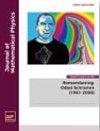某类图 C* 结构的量子对称刚性
IF 1.4
3区 物理与天体物理
Q3 PHYSICS, MATHEMATICAL
引用次数: 0
摘要
在过去的几年里,人们根据不同的表述对图 C* 矩阵的量子对称性进行了研究。我们已经知道,紧凑量子群 (C(S1)∗C(S1)∗⋯∗C(S1)︸|E(Γ)|-times,Δ) [简言之,*|E(Γ)|C(S1)、Δ]总是作用于 Joardar 和 Mandal 所引入类别中有限、连通、有向图 Γ 的图 C* 代数,其中 |E(Γ)| Γ 中边的数目。在本文中,我们证明了对于某一类图,包括托普利兹代数、量子奇异球、矩阵代数等,其相关图 C*-代数的量子对称性仍然是*|E(Γ)|C(S1),Δ,如前所述。更确切地说,如果一个有限的、连通的、有向图 Γ 满足以下图论性质:(i) 不存在任何长度≥2 的循环 (ii) 存在一条长度为 (|V(Γ)| - 1) 的路径,该路径包含所有顶点,其中 |V(Γ)| Γ 中顶点的数目 (iii) 给定任意两个顶点(可能不是不同的),最多存在一条边连接它们,那么普遍对象与 *|E(Γ)|C(S1),Δ 重合。此外,我们还指出了一些违反上述假设的反例。本文章由计算机程序翻译,如有差异,请以英文原文为准。
Rigidity on quantum symmetry for a certain class of graph C*-algebras
Quantum symmetry of graph C*-algebras has been studied, under the consideration of different formulations, in the past few years. It is already known that the compact quantum group (C(S1)∗C(S1)∗⋯∗C(S1)︸|E(Γ)|−times,Δ) [in short, *|E(Γ)|C(S1),Δ] always acts on a graph C*-algebra for a finite, connected, directed graph Γ in the category introduced by Joardar and Mandal, where |E(Γ)| ≔ number of edges in Γ. In this article, we show that for a certain class of graphs including Toeplitz algebra, quantum odd sphere, matrix algebra etc. the quantum symmetry of their associated graph C*-algebras remains *|E(Γ)|C(S1),Δ in the category as mentioned before. More precisely, if a finite, connected, directed graph Γ satisfies the following graph theoretic properties: (i) there does not exist any cycle of length ≥2 (ii) there exists a path of length (|V(Γ)| − 1) which consists all the vertices, where |V(Γ)| ≔ number of vertices in Γ (iii) given any two vertices (may not be distinct) there exists at most one edge joining them, then the universal object coincides with *|E(Γ)|C(S1),Δ. Furthermore, we have pointed out a few counter examples whenever the above assumptions are violated.
求助全文
通过发布文献求助,成功后即可免费获取论文全文。
去求助
来源期刊

Journal of Mathematical Physics
物理-物理:数学物理
CiteScore
2.20
自引率
15.40%
发文量
396
审稿时长
4.3 months
期刊介绍:
Since 1960, the Journal of Mathematical Physics (JMP) has published some of the best papers from outstanding mathematicians and physicists. JMP was the first journal in the field of mathematical physics and publishes research that connects the application of mathematics to problems in physics, as well as illustrates the development of mathematical methods for such applications and for the formulation of physical theories.
The Journal of Mathematical Physics (JMP) features content in all areas of mathematical physics. Specifically, the articles focus on areas of research that illustrate the application of mathematics to problems in physics, the development of mathematical methods for such applications, and for the formulation of physical theories. The mathematics featured in the articles are written so that theoretical physicists can understand them. JMP also publishes review articles on mathematical subjects relevant to physics as well as special issues that combine manuscripts on a topic of current interest to the mathematical physics community.
JMP welcomes original research of the highest quality in all active areas of mathematical physics, including the following:
Partial Differential Equations
Representation Theory and Algebraic Methods
Many Body and Condensed Matter Physics
Quantum Mechanics - General and Nonrelativistic
Quantum Information and Computation
Relativistic Quantum Mechanics, Quantum Field Theory, Quantum Gravity, and String Theory
General Relativity and Gravitation
Dynamical Systems
Classical Mechanics and Classical Fields
Fluids
Statistical Physics
Methods of Mathematical Physics.
 求助内容:
求助内容: 应助结果提醒方式:
应助结果提醒方式:


